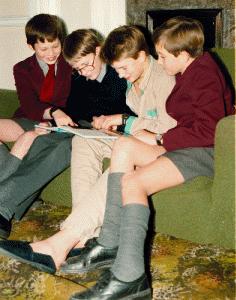
Traditional British prep schools were boarding schools, but day schools in recent years have become increasingly important.
Only a handful of schools known as public schools existed at the beginning of the 19th-Century. Enrollment increased significantly, however, as the 19th Century progressed and Britain's Empire grew. Imperial expansion required that Britain assign an increasing numbers of civil servants and military personnel overseas. In an era before air travel, such overseas postings were often for extended periods with wives usually accompanying their husbands. It was generally accepted that school-age children should be educated at home in Britain. This

Traditional British prep schools were boarding schools, but day schools in recent years have become increasingly important. |
Public schools at the beginning of the 19th Century accepted a wide range of ages, including quite small boys--sometimes 8 or 9 years old and in exceptional cases even younger ones. For many of these younger children, public school proved to be nothing short of trial by ordeal. Their status at the bottom of the public school hierarchy was perilous indeed. The ample literature on the public schools describes such experiences in detail. Eton's Long Chamber; Harrow's initiatory ordeal of blanket toss, gauntlet, and "pinching"; Rugby's "lamb singing", roastings, and Anstey's hole; Westminster's kicking ordeals; and Winchester's "tin gloves" were just a few of the horrors perpetrated on junior boys.
Educators increasingly realised that special provision had to be made for the needs of junior boys. The problem was compounded as the public schools expanded their rolls in the mid-19th Century and many new schools were founded. The fagging system theoretically offered some protection, but depended on the personality of the senior boys and the system was subject to great abuse. Some schools employed "dames" to care for the youngest students, housing them separately. Other public schools set up their own petty schools, qualifying perhaps as the earliest preparatory schools. Dr. Arnold at Rugby restricted entry to boys at least 12 years old in 1837-38, but most public schools did not immediately follow suit. Gradually in the latter half of the 19th Century, however, more and more schools narrowed the age range to 13-18 years. This specialisation by the public schools was a key factor in the rise during the mid-19th Century of a new educational institution--the fully independent preparatory school for young boys.
Details on this historical development as well as some period photographs
are in our book.